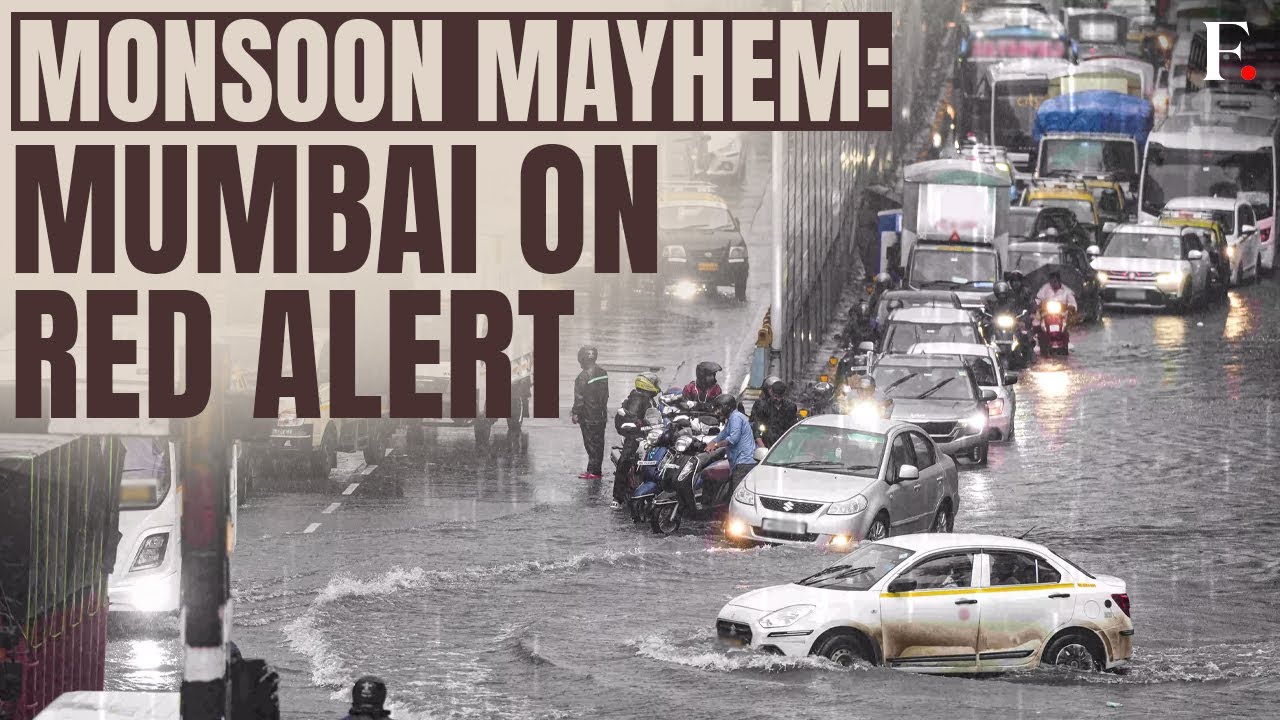Mumbai, often described as the “city that never sleeps,” was brought to a grinding halt between August 18 and 19, 2025. In just 84 hours, the metropolis received nearly 500 mm of relentless rainfall, turning bustling streets into rivers and paralyzing transportation. While the city has battled countless monsoon seasons, this time the scale of chaos was extraordinary. Two lives were tragically lost, one person went missing, and thousands faced disruption as floodwaters swallowed homes, roads, and stations.
The rains didn’t just bring water—they brought the city face-to-face with its vulnerabilities in infrastructure, preparedness, and transport. The drama reached a peak when a monorail broke down mid-journey, stranding hundreds of passengers in suffocating conditions high above the flooded streets.
This is the story of Mumbai’s monsoon trial: a tale of nature’s wrath, civic challenges, human resilience, and the lessons yet to be learned.
The City Turns into a Waterworld
From Dadar to Chembur, Sion to Matunga, the city was transformed into an expanse of murky water. In many neighborhoods, water rose to waist level, cutting off roads, stalling buses, and submerging vehicles. Drainage systems, already under immense strain, collapsed under the volume of water.
For residents, it felt like déjà vu—the city has experienced similar breakdowns before—but the sheer scale this year was unprecedented. Offices declared work-from-home policies, schools and colleges shut down, and government advisories urged citizens to avoid stepping out unless absolutely necessary.
Apartment basements flooded, cars floated in parking lots, and families were forced to use boats or makeshift rafts to get essentials. Mumbai, known for its tireless pace, had been forced into an involuntary pause.
The Red Alert That Raised Alarm
The India Meteorological Department (IMD) issued a “red alert,” warning of “very heavy to extremely heavy” rainfall accompanied by gusty winds reaching up to 55 km/h. This was not a routine weather update—it was a clear signal that danger was imminent.
The alert extended beyond Mumbai to Thane, Raigad, and surrounding districts, amplifying the scope of concern. The government’s response was swift:
- 525 pumps and mini-pumping stations were deployed to clear floodwater.
- Emergency holding ponds were set up to divert excess rainwater.
- Rescue and relief camps distributed food, water, and medical aid.
- Deputy CM and BMC teams appealed for citizens to stay indoors.
Despite these measures, the rain kept coming, overwhelming even the most prepared systems.
48 Hours of Uncertainty
Chief Minister Devendra Fadnavis addressed the state, calling the next 48 hours “crucial.” The Mithi River, notorious for flooding during heavy rains, rose dangerously close to breaching levels. Evacuations began in parts of Thane and Palghar where wall collapses and landslides worsened the crisis.
Rescue boats and buses were deployed to shift families from submerged homes. The National Disaster Response Force (NDRF) joined local teams to save stranded residents. Yet, with villages cut off and communications faltering, the anxiety of what lay ahead was palpable.
The Monorail Meltdown: Elevated Nightmare
If the flooding wasn’t enough, the city’s transport system faced one of its most unnerving incidents on August 19. At around 6:15 pm, a Mumbai Monorail train broke down between Mysore Colony and Bhakti Park stations. The power cut halted the train mid-air on an elevated track, trapping between 100 and 400 passengers.
Inside the monorail, the atmosphere quickly turned tense. Without functioning ventilation, the air grew hot and suffocating. Passengers panicked, some attempting to smash windows for relief. Videos surfaced online showing families crying, children gasping, and commuters pleading for help.
The Rescue Drama
The Mumbai Fire Brigade swung into action, deploying hydraulic ladders, cranes, and even scissor lifts to reach the stranded monorail. Windows were broken deliberately to allow fresh air inside. After nearly two hours of painstaking effort, passengers were evacuated—some through ladders, others with safety harnesses.
By 9 pm, the ordeal ended, with passengers escorted to buses and medical help. A few were hospitalized due to suffocation. While no lives were lost, the incident sparked widespread anger over the monorail’s safety record and emergency preparedness.
Why Did the Monorail Fail?
Initial investigations revealed that the failure stemmed from a power supply issue combined with overcrowding. The train’s emergency brakes were triggered when excess weight on a curved track created mechanical disconnect. This combination caused the train to stop abruptly and lock in place.
Officials later clarified that services between Wadala and Chembur resumed partially, but the trust of passengers took a hit. The breakdown highlighted two glaring issues:
- Inadequate emergency response planning for elevated train systems.
- Chronic overcrowding that continues to plague Mumbai’s transport, pushing infrastructure to breaking point.
Suburban Railways & Airport Disruptions
While the monorail grabbed headlines, Mumbai’s suburban railway system—the city’s true lifeline—was no less affected. Tracks in areas like Parel, Kurla, and Dadar were submerged, forcing suspension of services on central and harbour lines. Commuters were stranded at stations for hours as announcements of delays poured in.
The main line between CSMT and Thane remained suspended for over eight hours. Only late at night did limited services resume. Still, rail officials vowed not to halt operations entirely, emphasizing that trains must run, however limited, for essential workers and medical staff.
Air travel was not spared either. At Chhatrapati Shivaji Maharaj International Airport, flights were delayed by nearly 40 minutes on average. Several flights were diverted to nearby cities, leaving passengers stranded in terminals. Airlines scrambled to accommodate affected flyers with rescheduled departures.
Evacuations and Human Spirit
As waters rose, evacuation became a priority. Over 400 residents near the Mithi River were shifted to shelters. In Thane and Palghar, entire families were relocated from collapsing homes and flooded villages. Relief camps offered hot meals, water, and medical attention.
Perhaps most inspiring was the spirit of Mumbai’s citizens. Volunteers organized food packets, private vehicles ferried stranded commuters, and local groups opened temples and halls as makeshift shelters. Once again, the city’s resilience shone through the gloom.
Mumbai’s Monsoon Test: Key Takeaways
- Rainfall Intensity: Nearly 500 mm in 84 hours proved too much for drainage systems to handle.
- Transport Paralysis: Suburban trains, monorails, and flights—all disrupted simultaneously—exposed infrastructure fragility.
- Safety Concerns: The monorail breakdown raised urgent questions about passenger safety in emergencies.
- Civic Response: Fire brigades, NDRF teams, and BMC workers displayed efficiency, but were often playing catch-up against nature’s fury.
- Community Strength: Citizens stepped up where systems faltered, offering food, shelter, and support.
Lessons for the Future
As Mumbai looks to recover from this episode, several questions remain:
- Can drainage systems be modernized to handle extreme rain, especially with climate change increasing weather volatility?
- Will public transport operators introduce stricter load management to avoid overcrowding disasters?
- Are emergency communication systems strong enough to warn citizens and coordinate evacuations faster?
- What role will urban planning play in preventing construction on flood-prone land?
This year’s monsoon isn’t just about floods—it’s about foresight. Mumbai’s growth must be matched with resilient infrastructure if the city hopes to withstand future storms.
Conclusion: A City Tested, A City Standing
Mumbai’s monsoon has always been part of its identity, but 2025 reminded everyone of the thin line between routine rains and disaster. The city faced a triple blow—floods, transport paralysis, and a terrifying monorail breakdown. Yet, amid chaos, the resilience of Mumbaikars, emergency workers, and community networks became the city’s saving grace.
As the red alert continues until Wednesday, uncertainty lingers. But if one thing is certain, it is Mumbai’s unyielding spirit. Through floods, breakdowns, and warnings, the city continues to fight—determined to emerge stronger, even when the skies seem determined to test its resolve.

